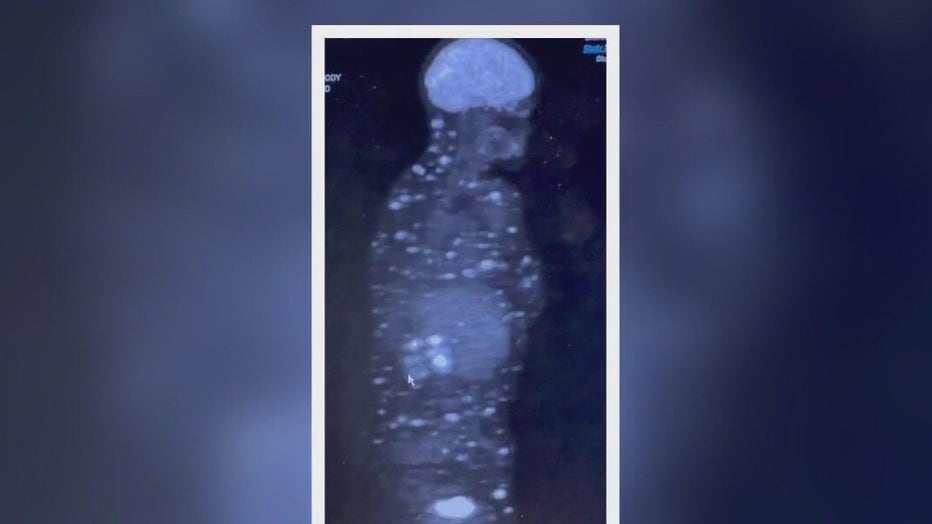Texas woman, two-time melanoma survivor, raises awareness about skin cancer
Texas woman raises awareness of skin cancer
According to the American Cancer Society, while melanoma accounts for only one percent of skin cancer cases, it causes a majority of skin cancer deaths.
ROUND ROCK, Texas - May is Melanoma and Skin Cancer Awareness Month.
According to the American Cancer Society, while melanoma accounts for only one percent of skin cancer cases, it causes a majority of skin cancer deaths.
"Of course, in the 70s and 80s, sunscreen really wasn’t a thing. I got sunburned a lot. I have fair skin, freckles, blue eyes, then in high school, against my parents' wishes, I went into a tanning bed, probably did tanning bed throughout college," said Cynthia Smith, a melanoma survivor.
It was something that eventually caught up to Smith, from Lampasas. She is not a two-time survivor of melanoma, a cancer of the cells that create pigment in your skin, and often presents as dark spots.
Smith's first diagnosis of Stage 2B was in September 2021. Doctors removed a nodule from Smith's back, checked her lymph nodes and gave her the all clear.
"Two months later, I had it all over my body. I was stage 4," Smith said. "A lot of people think that melanoma is only on the skin, which I guess I always thought, too. But, most of mine were nodules under the skin. So, I noticed some bumps on my forehead and I thought these were weird cysts."
"So, when I had my pet scan a few weeks later, I was literally covered in it inside. I had three on my skin, and the rest were all over the inside, bones, lymph nodes and luckily not organs, that’s probably what saved me," she added.

Dr. Ojas Vyas, who treated Smith, is a medical oncologist at Baylor Scott and White Cancer Center in Round Rock.
"The unique thing about melanoma is its ability to spread, unlike other skin cancers. Melanoma has a very strong ability to spread to the lymph nodes or through the blood to other parts of the body. So, it’s very critical to catch it early and treat it," said Dr. Vyas.
"Thankfully, we have things we can do to make the treatment more successful, and, these days, we can use immune treatments and things like that to help the immune system recognize the cancer and prevent it from spreading and reduce the risk of it coming back," Dr. Vyas added.
For Smith, that treatment of nearly two years has worked.
"She had nodules throughout her body, and she is done with her treatment and is doing amazing things without any evidence of her cancer," said Dr. Vyas.
MORE HEALTH BEAT STORIES:
- Irregular heartbeat is more dangerous in younger people: study
- Woman's cardiovascular risks increase after going through menopause: study
- Mosquitos, and their diseases, return to central Texas with warmer, wet weather
These days, Smith is committed to wearing sunscreen and protective clothing, and limiting sun exposure. Both she and Dr. Vyas wants people to do the same and recognize the A-B-C-D-E rule of melanoma:
- A — Asymmetry: One half of a mole or birthmark doesn't match the other.
- B — Border: The edges are irregular, ragged, notched or blurred.
- C — Color: The color is not the same all over, and may include different shades of brown or black.
- D — Diameter: The spot is larger than a quarter-inch across the size of a pencil eraser. Although melanomas can sometimes be smaller.
- E — Evolving: The mole is changing in size, shape and color.
For those who continue to be sun-worshipers or frequent tanning beds, Smith wants you to ask yourself this very important question.
"Is it really worth your life to be tan?" Smith questioned.
Smith told FOX 7 Austin when she was diagnosed with stage four melanoma, she made an announcement on Facebook urging friends to stay out of tanning beds and get their skin checks.
She said a few of her friends told her, because of her post, they did get checked, and were diagnosed with early stage melanoma, which is easily treatable with removal.

